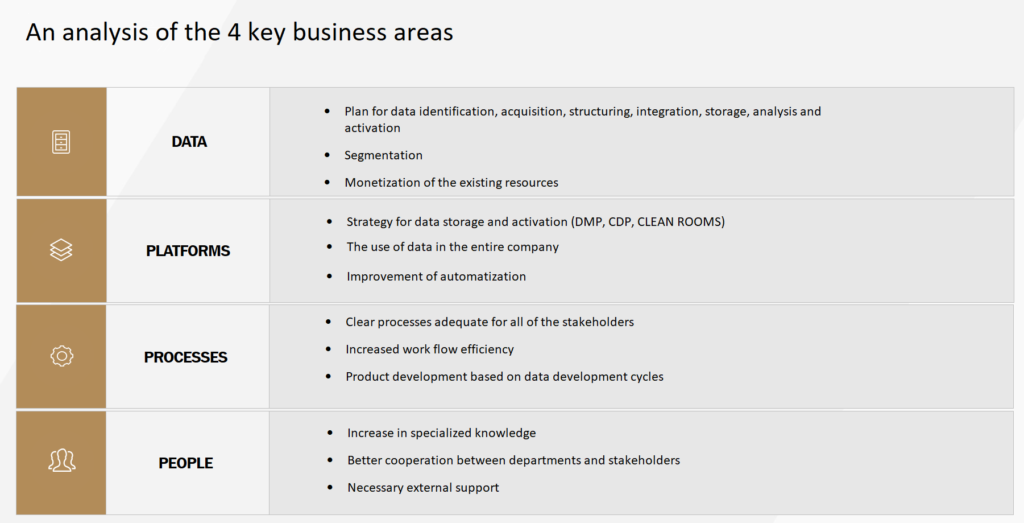In short, digital marketing as we know it to date will change in virtually every way. Campaign targeting, created segmentations or persona based on data other than your own (1st party data) will be virtually impossible outside the ecosystems of so-called Walled Gardens or other entities with their own data, which will significantly impact digital campaign activations. Measurement and metrics that we took for granted will soon be unavailable.

For people involved in digital communications, the topic of lack of support for 3-party cookies by browsers is nothing new. This is a part of a long-lasting trend of limiting the possibilities of data processing (usually connected with the issue of users’ privacy on the web). This trend manifested itself with the introduction of the General Data Protection Regulation (GDPR) in 2018, the systematic restriction of the possibility of processing data contained in 3rd party cookies by Firefox or Safari browsers or the successive iOS updates introduced by Apple and their impact on the IDFA (a direct cause of the open conflict with Facebook). The culmination of this trend, however, is the move by Google, which has decided that the Chrome browser will no longer support 3rd party cookies, thus sealing the entry into force of what we now call the “cookieless world” due to its global browser market share of about 63%[1].
If we look at it from a broader perspective, we are dealing with a paradoxical situation. There is more data to analyze than ever, fewer opportunities. Pandemic-driven changes have fundamentally altered social and consumer behavior. The digitalization of our lives has been dramatically accelerated, accompanied by a huge increase in the amount of data generated that speaks of online behavior and the emergence of new digital touchpoints[2], touchpoints that will soon be significantly limited for us to analyze.
The process of building competitive advantages in business, searching for sources of efficiency gains and innovations and new connections with consumers expressed in digital transformation processes, becomes even more complicated at this point. As if, until now, it hasn’t posed a formidable challenge.
Data reported by the CMO Council in 2020[3] shows that
as many as 97% of marketers surveyed believe their organizations are ineffective at turning data into valuable insights or initiatives.
In the face of the challenges presented by the cookieless reality and the opportunities presented by the volume of consumer data being generated today (an issue described by Gartner, among others, identifying “Digital of Behavior” (DoI) as a trend in 2021)[4], it is important to act decisively, but thoughtfully.
The truth is that for years we have complained about the quality of cookie technology, but at the same time the fact is that it has been the foundation of all digital marketing and most of the processes that make up our daily work. So it is a reasonable and natural step to verify how much we depend on 3rd party cookies in our business. We will be able to prepare for this future only if we know the level of our business dependence, i.e. define “what the cookieless reality means for my business here and now”. The next stage should be to honestly and sincerely answer the question whether my strategy takes the upcoming changes into account and whether I implement processes ensuring my business will dynamically develop in the new reality. In the current situation, if you are still among the 36% of marketers who say they have no data enabling them to get to know their consumers (the aforementioned CMO Council study from last year), it is high time to leave this group.
How do you do it? Firstly, with care and in a thoughtful way.
The first step should be a thorough verification of key business areas dependent on 3rd party cookies. Here I mean such categories as broadly understood Data Management, the use of cookie data for the needs of creative optimization, or the implementation or activation of media activities. Rules and processes concerning the measurement and verification of currently used performance indicators are an obvious necessity. What is important, despite appearances, such an audit does not have to last for months and can be conducted very efficiently in a short period of time. Its results will secure the operational continuity of our activities.
Can preparing to become cookieless be more strategic?
It should be. Programs that analyze and improve the data maturity of enterprises (Data Maturity Models) have never been more relevant and important than in the face of cookieless.
An example of a framework description of activities in the 4 areas of the DMM model:

The effectiveness of this type of project stems from the fact that the entire process is organizationally aligned with the individual needs of a given business. What is more, the results of individual stages are verified and evaluated on an ongoing basis, so that the main goal is never lost, which is not only the efficient functioning of business in the new digital reality, but building real competitive advantages. In practice, we get the following benefits:
- Precise (qualitative-quantitative), comprehensive diagnosis of the state of “dan” maturity
- Indication of significant areas and gaps that need to be modified or completely changed
- Identification of areas with potential to increase organizational efficiency by transforming data into real business value
- Support business strategies through customized project implementations
- Promoting the democratization of access to data and creating effective processes and technological solutions for this purpose
The cookieless reality is a moment of change that redefines the main assumptions of digital, and therefore the key elements of doing business.
As always in such moments – how we take advantage of this opportunity depends on the decisions that need to be made now.
[1] https://gs.statcounter.com/browser-market-share
[2] 90% if the world’s data resources have been created in just the past two years!; https://techjury.net/blog/how-much-data-is-created-every-day/#gref
[3] https://www.cmocouncil.org/thought-leadership/reports/forging-the-future-of-customer-experience
[4] https://www.gartner.com/smarterwithgartner/gartner-top-strategic-technology-trends-for-2021/

